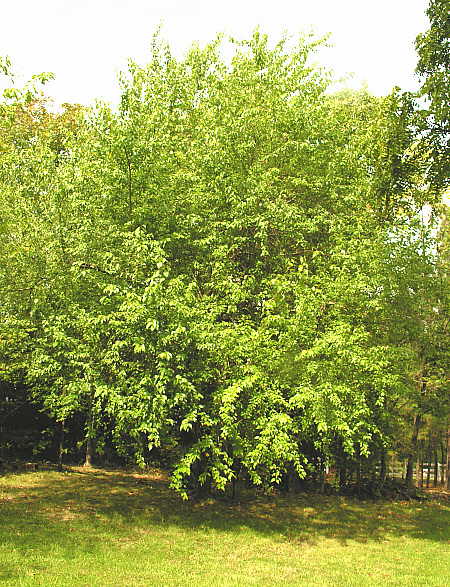
This is a tree with various names. Some refer to it as the bois d’arc (pronounced “bodark”), which is french for “bow wood.”  It is also referred to as an Osage orange tree, hedge apple tree, and horse apple tree. All of these monikers have a basis in the properties of the tree, as we shall see in the following paragraphs. Some people dislike these trees, while others adore them, depending upon their perspectives.
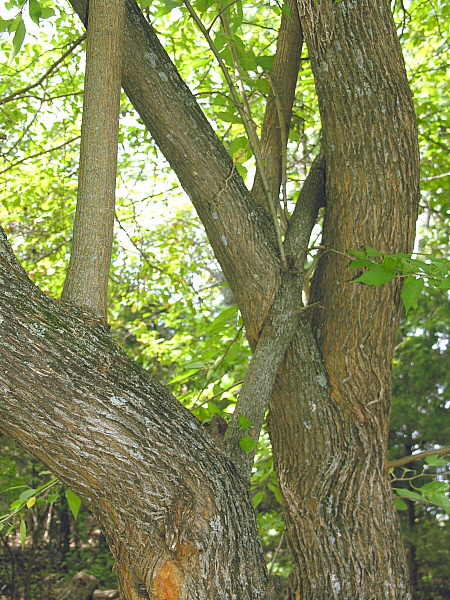
The picture above is a trunk of a bois d’arc tree. The wood of this tree is extremely hard and tough, which makes it a sought after tree for cutting into fence posts. But if you intend to cut one of these trees, you had better arm yourself with plenty of sharp chains on your chainsaw, as the tough, yellowish wood of the bois d’arc will dull the chain rapidly. It is also advisable to wear long sleeves made of thick fabric, as the spines on the branches can cause painful lacerations if you are not careful.
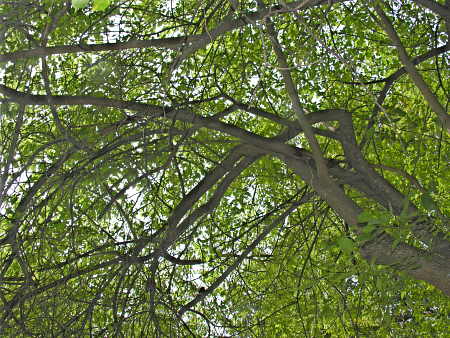
The canopy of the bois d’arc forms a tangled mass of branches, which are armed with stout, flesh-piercing barbs. Because of the dense mass of resilient, barbed and tough wood that the tree produces, it was planted with tight spacing as a hedge row in times prior to the invention of barbed wire. It is referred to as being “horse high, bull strong, and hog tight,” an ideal specification for a farmstead hedge row. Because of the toughness and decay resistance of the wood, combined with the long, straight, resilient branches that this tree produces, it was prized as a source of wood in which to construct bows in the past, hence it’s name bois d’arc tree, or bow wood tree.
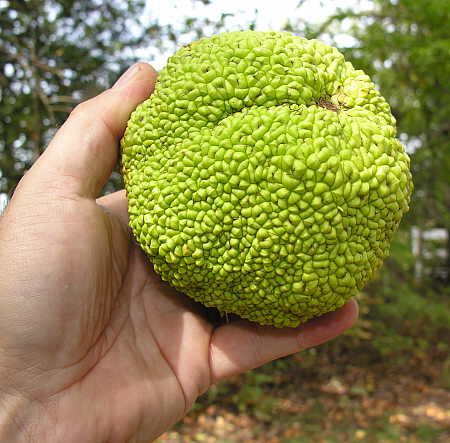
This is the fruit produced by the bois d’arc. Some call this the Osage orange, possibly because the skin emits a citrus-like scent when it begins to rot. Because the trees were often grown as a hedge, the fruit has been called a “hedge apple” by some. Because the fruit is consumed by horses, it is termed a “horse apple” by others. Osage orange, hedge apple, or horse apple, it remains that humans do not consume this fruit. But, as just mentioned, horses eat the fruit of the bois d’arc tree, as well as squirrels and cattle.
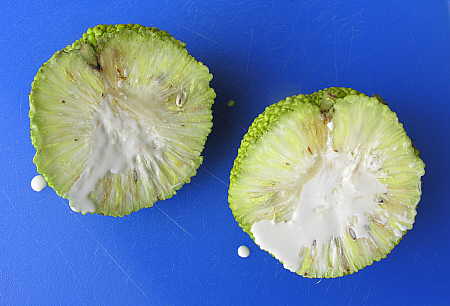
If you slice the fruit in half, which requires a stout knife, as the fruit is quit hard until it begins to rot, you will find that after a minute or two the fruit begins to “weep”, as you can see in the photograph above. Only the female tree produces the fruit, which propagates the tree through the germination of the approximately 200 seeds contained within the fruit. In the fall, the fruit begins to drop from the limbs of the tree, and when they do, watch out, as it hurts to be struck by the falling, heavy, hard fruit of the Osage orange, or bois d’arc tree.



One way to completely remove one of these trees is to burn it, stump and all. Most trees will burn to the ground only, this will emit a blue flame
like propane and burn below ground. Do not use a stump grinder here or your wallet will suffer
I grew up on a ranch in western Oklahoma and we had over 30 miles of fences. I have dug post holes for a number of bois d arc posts. (We called them bodark). My grandfather put in a bois d arc post in 1912 and it is still standing.
I understand that Kansas State University (or someone in Kansas) found thornless bois d arc trees and that they are selling the male trees for yard trees. Where can I get some?
Could someone please tell me where I can go to cut some of the wood? I am disabled, and I make walking sticks and canes for others who also have difficulties in walking. This I do to help provide for my family.
Will anyone be kind enough to direct me to a place I can aquire some of this wood?
Thank you!
What area of the country are you looking to find the wood?
Liesa,
Can you walk around, carry a saw, bend under a tree? Is NW Oklahoma to far to travel?
I grew up on a farm in Hancock county, Illinois–1930’s & 1940’s
Old hedge rows still existed but had deminished by a great deal since my youth. I noticed some Osage Orange trees in S.E. Kansas when traveling —
suspect some wild scattered Osage is in south Missouri.
Great site, thanks for the ability here to comment. I’m writing from Connecticut where one of these trees has flourished for years, suddenly today I noticed our Public Works department cut it down to the ground. I am amazed at their insensitivity as it seems rare that a tree like this would grow in Connecticut in the first place? Aren’t they rare to this area? Thanks for any help.
Jim
Jim,
According to the National Audobon Society Field Guide, the natural range of Osage-orange is in the Red River drainage of Oklahoma, Texas, and Arkansas; and in the Blackland Prairies, Post Oak Savannas, and Chisos Mountains of Texas. According to some authors the original range included most of eastern Oklahoma, portions of Missouri, and perhaps northwestern Louisiana. Osage-orange has been planted as a hedge in all the 48 contiguous States and in southeastern Canada. The commercial range includes most of the country east of the Rocky Mountains, south of the Platte River and the Great Lakes, excluding the Appalachian Mountains.
Very interesting, I discovered this article in a completely roundabout accidental way. I was actually researching a bois d’arc conservation area in Springfield….and discovered it was named after the nearby town which was named after the tree. And, that’s when it hit me, when I was helping to build barb wire fence as a 16 year old girl on our 160 acre ranch, we would cut down these trees to use as fence posts. The thorns though were brutal but we were told they would make the strongest fence posts known to man. We had hundreds of them and of course, they were actually all along where we were building/repairing the fence, which tells me perhaps someone had already manipulated them into a n natural fence for that particular pasture. I never knew it was spelled this way, only being told verbally they were BODARK trees….and I never ever saw this name of tree anywhere in the 28 years since. So, I enjoyed the thorough education on a tree from my distant past. 🙂 I may have to check out getting some of the fruit though to see if they really do repel insects!
Comfortabl y, the post is really the freshest on this deserving topic. I harmonise with your conclusions and also will thirstily look forward to your next updates. Just saying thanks will not simply be adequate, for the extraordinary clarity in your writing. I will directly grab your rss feed to stay informed of any updates. Gratifying work and also much success in your business dealings!
Pingback: Huh? « Ranch Ramblins
We just regrettably, cut a male bois d’arc tree today. The diameter of the tree at its base measures 38 inches. Its entire trunk was shrouded in English ivey, and it was just too close to our home’s rooftop, so it had to go. If I had realized the value of this wood for artisan purposes, I would have gladly sent out word of this before the trailer hauled it away (with tandem 16″ wheels scraping the fenders) I still have some 3-6 inch chunks of one or two of the limbs, along with random branches. Yes, the growth in the canopy was tangled and disorganized, but even my tree specialist showed no affection for it. Although it was a nuisance, I was missing it before the last section of trunk hit the ground. I admired those thick grooves in the bark. . .now wondering about its use for landscaping, mulch, etc. .?
In 2008, while working in Los Angeles as an Ozzy Osbourne impersonator, I broke my neck during a performance. The injury forced me to move back to Garland, Texas to be with my family to recover. Only partially paralyzed, I began using yardwork as physical therapy. During the yardwork, I was told to cut down two Bois D’ Arc trees and several oaks. I managed to “trim” the trees severely. I kept the wood to make small runs of custom lumber. The only things that are being made are practice swords and Frat paddles. My dad is buying 100 bf of it for a carving groupthat he is in. The wood is beautiful and worth the trouble to work it into beautiful objects. I am a fan of these trees and enjoy this site.
How can you tell the difference between bois d’arc wood posts and treated pine posts?
Does anyone know if bois d’arc wood posts were cut square 40 years ago or cut round like most corner posts are cut today?
the wind just tore one of these trees (I believe to be a male) last week. I think I will get some pieces before the trash peop[le come by.
Aroo – I live in North Texas and the post’s around here are old and all are square cut.
We have a very large fruitless & thornless Bois d’arc tree behind our home that I absolutely love. It’s huge and offers wonderful shade. It’s great for climbing too!
We have a HUGE tree in our yard and I have found this site and believe it to be the male tree. It has to be old because two of us can’t put our arms around the trunk. One limb has fallen off and I am worried about it splitting more. My husband loves to trim it and keep it healthy and we are looking for information on it. Now I want to carve stuff out of this limb!! Thanks for the info!
The Living Farm Museum of the Ozark (Arkansas )needs sorcue for seed/plants to start an BoArk (Osage Orange) fence.
I have about 200 feet of old hedge row bois d’arc at the back of my acre lot – male and female trees. You are welcome to all seedlings you want. These trees spread quickly. Also, the hedge apples are coming down now.
hi im pete. i like working with woods. i like to find my pieces naturally through out this beautiful country.
as of now i cannot travel to hwere it can be found.if by chance you have pieces of this would naturally in your area i would love just enough to handle both sides of a pocket knife. thank you so much. peteforce@gmail.com i have found places i can but it but i like scraps from where they are found locally that i can work with.
-peter force
what i meant is i can buy it from sites ….but i like materials used from the places they are found….its a history thing with me…i dunno.
Has anyone used the tree for bridge construction? I live in East Texas and bridges to cross creeks are very expensive. I have considerable trees available, some large; however joining the trees together and finding straight trunks long enough will be a problem unless I can join them in a cost effective manner. I believe I can purchase old flatbed trailers a lower cost to solve my crossing problem than if I try to cut the wood into lumber for construction. I am considering using the whole trunk of trees joined together to make a soil covered bridge approx 12′ to 14′ wide and 20′ to 24′ long. Anyone ever tried it before that may have advise?
i am 62 yrs of age, and i have never seen anything like the fruit that is currently falling from an extended family member’s trees….he has three of them, that i noticed. as we picked them off the ground couldn’t help but notice that there was not an ant or bug on them! This is Georgia! temps are still in the high 80’s right now. thought the fruit was so unusual looking i brought a few home and put in a dish on a table, unusual centerpiece! i will def pass the info along to the owner of these trees, not sure he knew what they were? apparently they were on this property for awhile, large trees with good sixed circumferences. thanks to UGA for this info!!
Chief (my dad) said, if you use a BODARK post shortly after it is cut, it will root and become a fence tree (post)
Until yesterday, I had never heard of or seen an Osage Orange. On a walk through the Oconee National Forest (Greene County, Georgia), a group of us came upon these “huge green softballs†on the ground that one or two in the group recognized as the fruit of the Osage Orange tree. The trees from which the fruit had fallen were slender and easily 40 feet tall.
I brought one and a half fruits home, will attempt to extract some seeds and then we’ll see if I manage to grow a tree. 🙂
Speculating on the tree’s name, a horticulturist said rumor has it that the Ozark mountains (apparently the tree’s native home) are named after the tree – “oz†derived from the Osage people, and “ark†from the French bois d’arc. Another scientist, who led the walk around the ruins of the Scull Shoals settlement, mentioned a second speculation: that the Georgia town of Bogart is a derivative name of Bois d’Arc. Neither seems plausible to me, but I’m open to be proven wrong!
Today we discovered Osage Oranges floating on the shore of the Potomac River on Roosevelt Island, in Washington, D.C. We were so intrigued by the fruit that we asked people strolling by, and one person identified it as an Osage Orange. There were trees nearby that look like those on the photographs of this site. So add Roosevelt Island on the Potomac to the habitat for bois d’arc/bodark trees!
I found an Osage Orange today on the banks of the Delaware River, on the New Jersey side. I had no idea what it was till some FaceBook friends commented on it.
Wow, interesting! And HOW did it get up HERE ?!?!?!?
I live near the Potomac River a little downstream from Harpers Ferry, WV. I came to this site to see if I could identify a tree in my backyard and found this article. I’d never heard of of bois d’arc trees before and never saw one until I moved here nearly 20 years ago. Thanks for helping me to identify this tree. I’m happy to hear these trees are also on Roosevelt Island near DC and in Delaware.
Happened to find this website after finding out the name of the Bois D’arc from an arborist that I found when trying to find the name of the tree that produced that fascinating fruit – the horse orange. Our daughter was visiting us in North Texas and there are several of these trees on one of the main boulevards of this development. In November these horse oranges are on the ground. Her interest spurred me on to investigate. So glad to learn the history and importance of this tree. Will try and put some of the fruits on the table and see what interest it will inspire in my grands. I’ve enjoyed reading all of the comments. Thank you!
I found about 20 oranges here in California Bay area, on the road. i thought they were from the bread fruit family i set them around the opening of my basement in hopes they keep the large wood Cockroaches away.
I have discovered about 6 live very large bois d’arc trees on our property, and maybe 4 large trees that have fallen over. I cut some small limbs off one of the dead trees last week to discover the brilliant yellow wood. I wasn’t sure what it was until I looked on the internet. My chain saw may never be the same! Amazing looking wood!!
I have just this site and this tree. I want some. never seen them. I live in Mena,Ar. on the side of Rich Mountain. does anyone know if they grow around here anywhere? or can anyone mail me some seeds, if that the way you get them. thank Vallyne my email is bevthang@yahoo.com
I was searching for a meaning to the phrase ” like a ol bois d arc fence post” in the lyrics of “Choctaw Bingo” by James McMurty
Thanks for the great tree article I feel enriched!
My Dad has a Bodark tree on his property that is very very old. My Dad is 78 and the land belonged to his father. My grandfather died when he was 90 years old when he hit a snag in the water while going hunting in the dead of winter. He did not survive the 5 hours of treading water. Tough old bird! This tree has always been a great source of interest to me. Old and twisted and sitting on top of this hill all alone. Beautiful yet ugly and full of character. I did not know the history behind the tree until I found this site and I appreciate it so much. I can now relate the information to my sons who played around the tree as young boys and were always in awe of it. My youngest son is getting a mini lathe for his birthday and wants me to give him wood to make into duck calls and now I can tell him he has all the wood he needs at his Pawpaw’s house from the “Old Tree”. He asked me for Osage Orange wood. That is how I found this site. I was trying to find out what kind of wood it is and low and behold it is Bodark.
Wow there’s some neat stuff here, especially the folks from the DC/Chesapeake area finding the fruit. We live in a Dallas subdivision built around 1970 and have, on our tiny city lot, what appears to be a male and female version of this tree – we get fruit from one but not the other. By fruit I mean hundreds of these things although last year seemed a bit light. DART (Dallas area rapid transit) put up some posters at our station talking about the use of these trees for hedges pre-barbed wire. The trees shed small dead twigs all the time, but even in heavy ice that takes out live oaks, the branches are fine. There’s only two other trees I’ve ever seen in our area.
If you want the wood, can’t help you but if you wanted the fruit, gosh please come by in July and August and save me from picking it up.
I live in East Texas and my property is called Horseapple Creek because of the trees or course – we have about 20 bois d’arc trees. Can anyone tell me if flowers can grow around them? We trim them ever year which is tough on the old chain saw. They make good shade trees, some of the trees are coming out of the ground where the dirt has washed out around them. The wood is so hard it’s hard to cut them down. Also I have a Bois d’arc table which is about 150 years old. It was my grandmother’s. I would love to sell some of the wood if anybody is interested in it.
I was so excited to find this website. My mom had always said bois d’arc trees were so tough you would have difficulty putting a nail in. She told me about me about my ancestors using them for bows. Thanks for all the information.
The easiest way to propagate the Bodarc is to cut a “pencil” size branch, stick it in the ground & keep it watered. Done it many times.
To buy (or sell?) the wood look to the primitive archery forums.
I live in michigan and happened upon some at the local apple orchard last year. I am terrified of spiders and was told these oranges keep them at bay. Honestly i laughed, but purchased a few anyway. OMG it was true i never had a spider in my house for months. Even during decomp of the orange. For some reason spiders love my home, big black ones, and with the osage oranges one placed in every room these spiders left my home. Its now spring time, where if at all could i get some more of these wonderful items?
They r very interesting and unique trees, and extremely hard to cut. The thorns are BRUTAL as the tires to my riding mower can attest. I made the mistake of driving over some small branches I had trimmed. It took some doing with the pliers to remove as many as possible. Lesson learned!
I would be interested in some seedlings of the osage orange if someone still has them. We have lost trees due to the tornadoes and need a couple of these trees to plant, because we have troubles with spiders also.
My folks and I were heading back from Oklahoma from a visit and talking about the bois d’arc trees. Daddy told me how he had to cut fence post and how the wood didn’t in rings but grew in crisscross like a tick tack toe pattern. I was asking if it was a native tree to the US, or brought in, Dad didn’t know. When I was small, my Granddad told me the apple would turn the mother cows milk sour and the calf would quit nursing. I often wonder if this was true. When I was little I got a good stone bruise and popped a hole just right for a small bois d’arc thorn to nest in for a good while. Never told a sole it was there, for I was terrified someone would pick it. It finely festered out with a couple of pebbles.
Bodark is the french pronunciation of Bois D’Ark which means bow wood. French discovered the Osage Orange indian tribe using the wood for bows. Very strong, resilient wood. Search U-Tube to find people making bows. I live in about 60 miles due east of Dallas on my great-grandparents farm. My father and I rebuilt most of the fences using cedar posts and bodark corner posts in the 50’s & 60’s. He rebuilt again during the 80’s with treated pine. The pine posts are rotted again at the dirt level so I am currently refencing again. This time, bodark only. Hard to work with, but I still find bodark posts my grandfather used that are still good, but to hard to drive a staple.
Bodark is extremely heavy, very close to the weight of ebony. Unless you cut the trees during the dormant season, they ooze the same milky sticky sap seen on the fruit. Posts need to be used very soon after they are cut if you plan to staple wire directly to the post. If you store them until they cure, you have to drill hole for staples. One other characteristic I have read is the wood is so dense that it can be used for building electric fence without insulators because it will not absorb water like other wooden posts which shorts out the fence. I haven’t tried it yet, but I wonder if the bark needs to be stripped off and the post allowed to cure for a year or so to completely dry out. The ends of the post should also be painted to prevent checking.
where do we find seedlings?- in Houston area
When I was young I had a job doing ‘make readys’ on apts. One apt had a beautiful desk/vanity piece of furniture and I was told I could have it. It was very heavy and very carved. The more I looked at it after i got it home, the more curious I was about it. The wood was very hard, very orange-yellow and was hand made including carved curly cue designs running all around the edges. I knew it was old because of the syle, it was like a womans vanity tabel and dresser all in one. I now knos that it was an exquisite peice of vintage workmanship and made out of ‘ bodark’ wood. I had never heard of it until a woodworking neighbor andfriend mentioned it in passing. it was like an ‘ah-ha”! moment.
Does anyone have any information on how to grow these or where to purchase one (bodark tree) I would love to have a male and femail
Unfortunately the house we lived in burned to the ground,….all except my bedroom. I looked hard at my vanity and realized it was salvageable. Unfortunately too, My husband at the time refused to come back to the house and get it for me and I was tied down with three kids (little) no job and no car. They bulldozed the whole house and I wonder what happened to it.
right! I would like to know where in Texas retails these or the seeds? I first saw a horse apple in Wylie texas but have never seen another one. Are they endangered?
Bois D’arc seedlings can be ordered here:
http://www.musserforests.com/prod.asp?p=OSO
Hello to all. I live in Mississippi, and a lot of people consider these trees HUGE pests. They will tear a chainsaw up, if they need to be removed. I used to have my pretend playhouse under one when I was a little girl — the curving mass of branches made the perfect roof.
For those planting one from seed, I think it might need to go through a process before it will grow… we had the ‘horse apples’ several times, but never had the trees come up until an actual horse ate one, and, well, the seeds went through him. Those seeds are the ones that produced trees. Just as some seeds need to be soaked in water before they will grow.
By the way, in Mississippi, we call them bo-dock trees, with no ‘R’ sound at all. Just a little bit of trivia.
Bois D’Arc, I have been around this tree all my life and they are a very hardy species. As you may have all ready read the wood can have many uses. My favorite is to take very cured bois d’arc and use it for cooking on the grill or smoker. The results are a mild but evident smoke flavor in your food. I have smoked summer sausage and have had people try it and got rave reviews. A few that tried it had me to custom smoke them some. As I said the wood needs to be cut and dried for at least six months. If you are interested in cooking with bois d’arc and do not have access to any we have a good supply. We are in the DFW area.